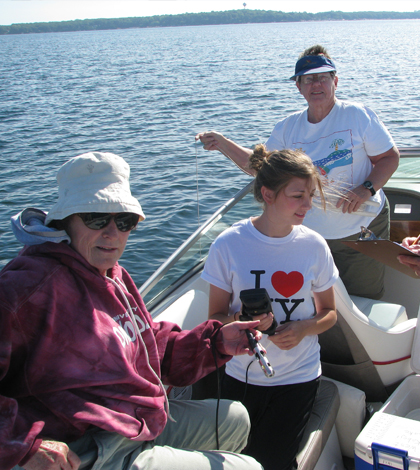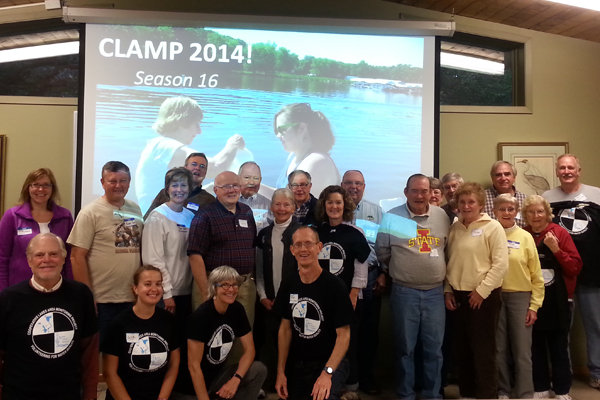Cooperative Lakes Area Monitoring Project Volunteers Fill Data Gaps For Iowa Great Lakes

Volunteers take Secchi depth, dissolved oxygen and temperature measurements. They also collect water samples for chlorophyll and nutrient analysis. (Credit: Jane Shuttleworth)
The Okoboji Region of Iowa is home to a group of glacial lakes sometimes called the Iowa Great Lakes. These abundant freshwater resources have supported the continued operation of the Iowa Lakeside Laboratory, a field station that has been open for 106 years.
As time has gone by, scientists at the lab have helped grow the field of limnology and amassed long-term datasets on many of the region’s lakes. One of Lakeside’s newest programs, at least in terms of centuries, is the Cooperative Lakes Area Monitoring Project (CLAMP), which launched in 1999. CLAMP is supported through donations and most of the work is done by volunteers who care about the Iowa Great Lakes.
“I always tell them that if they can learn how to follow a pancake recipe, they can be clampologists,” said Jane Shuttleworth, outreach and education coordinator at the Iowa Lakeside Lab. She oversees training the citizen scientists to use things like Secchi disks, YSI meters and sampling bottles.
All jokes aside, the work that the volunteers do is important. Because state scientists only make it to the region three times per year and only sample in one spot in each of the lakes, the citizen scientists fill a gap in the record. Instead of sampling just once, CLAMP volunteers go out multiple times per year, and collect more frequent, representative and robust datasets on water quality.
Conditions that the volunteers monitor include dissolved oxygen levels, which are measured using optical sensors on meters they help calibrate. Water clarity is tracked with Secchi disks. The water samples that they gather are analyzed by a spectrophotometer at the Lakeside Lab.

At the end of each sampling season, CLAMP volunteers are invited to a thank-you dinner and that includes review and discussion of the data they collected over the summer. (Credit: Jane Shuttleworth)
“It’s the perfect mix between volunteer work and research,” said Shuttleworth. “We have a certified water chemistry lab. A lot of other citizen scientist programs are not as refined.” She says that chlorophyll concentrations are also extracted in the lab.
The volunteers learn about lake processes and how they change due to environmental fluctuations. The experience also helps volunteers to become better leaders in area lake associations, says Shuttleworth, because it increases their knowledge and appreciation of lakes.
“It’s really satisfying to see the questions they ask and the explanations they come up with for data variations,” said Shuttleworth.
The complete dataset that volunteers have amassed now spans 16 years for some of the lakes. Shuttleworth says the data cover enough time that it’s possible to see trends. In the near term, they also help investigations looking at changes occurring in the lakes, like introductions of invasive species, algal blooms or installations of sewage pipes to fight nutrient pollution. Many of the data points are available on the monitoring project’s website.
“This is a great example of how biological field stations can educate the public,” said Shuttleworth. “Science has a lot to offer.”
By using volunteers, the cost of the program is cut considerably, she says. All other funding for the program is fundraised locally.
“Water doesn’t respect boundaries,” said Shuttleworth. “Collaboration is a very important point.”
Top image: Volunteers take Secchi depth, dissolved oxygen and temperature measurements. They also collect water samples for chlorophyll and nutrient analysis. (Credit: Jane Shuttleworth)




0 comments